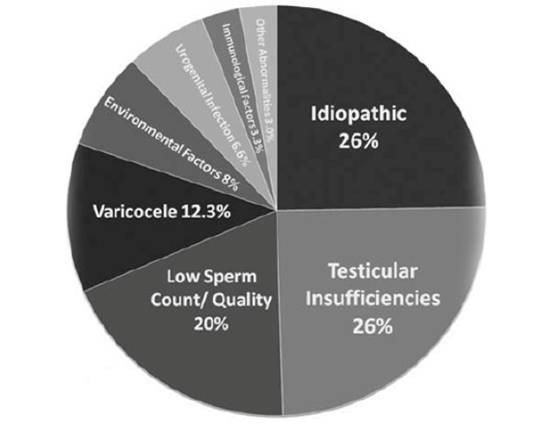Oocyte activation
January 07, 2016
We just discussed one issue of male factors in the infertility realm—azoospermia. Actually the entire proportion of male factors in the infertility indications is around 35-40%, and they were divided into the following groups.
By using several assisted reproductive techniques, such as intracytoplasmic sperminjection (ICSI) and intracytoplasmic morphologically selected sperm injection (IMSI), the average fertilization rate was raised up to 70%-80%. However, complete fertilization failure or very-low fertilization rate still occurred in around 1-5% of IVF-ICSI cycles. In this case, the issue of incomplete oocyte activation was concerned. The interactions between oocyte and sperm during fertilization was displayed as follows.
As the figure illustrated, the signal transduction began from the acrosome (sperm head) reaction. The phospholipase C zeta (PLCζ) was released from acrosome into the oocytoplasm, and thus the phosphotidylinositol 4,5-bisphosphate (PIP2) was decomposed as diacylglycerol (DAG) and inositol trisphosphate (IP3). Then the IP3 combined to the IP3 receptors on the endoplasmic reticulum and induced the release of stored calcium ions (Ca2+). The released Ca2+ flows activated the oocyte and turned on its cell cycle.
Globozoospermia (sperms with round head) is one of common causes in complete fertilization failure. It was because that round-head sperms lack acrosomes, and then no PLCζ turn on the pathway of oocyte activation.
Comparing the Ca2+ oscillation between the sperms resulted in higher and lower fertilization rate in the ICSI cycles, a Ca2+ oscillation with higher amplitude and frequency was induced by the sperms resulted in higher fertilization rate. In contrast, the sperms with lower fertilization rate either was unable to induce the oscillation, or induced an oscillation with weaker amplitude and frequency only.

Artificial oocyte activation (AOA) was reported as one way to solve the complete fertilization failure. This procedure can be done by three different methods:
1. Chemical AOA: Ca2+ ionophores (A23187), ionomycin, puromycin, and so on. (most common)
2. Electric AOA: using electric shock to induce the Ca2+ oscillation
3. Mechanic AOA: injection of Ca2 into the oocyte directly. (less common)
References:
· Kashir J, Heindryckx B, Jones C, De Sutter P, Parrington J, Coward K. Oocyte activation, phospholipase C zeta and human infertility. Hum Reprod Update. 2010 Nov-Dec;16(6):690-703.
· Yoon SY, Jellerette T, Salicioni AM, Lee HC, Yoo MS, Coward K, Parrington J, Grow D, Cibelli JB, Visconti PE et al. Human sperm devoid of PLC, zeta 1 fail to induce Ca2+ release and are unable to initiate the first step of embryo development. J Clin Invest 2008; 118:3671–3681.
· Mohammad Hossein Nasr-Esfahani, Mohammad Reza Deemeh, Marziyeh Tavalaee. Artificial oocyte activation and intracytoplasmic sperm injection. Fertility and Sterility, Published online: April 27 2009.
· John Zhang, Chia-Woei Wang, Anna Blaszcyzk, James A Grifo, Jean Ozil, Elisa Haberman, Alexis Adler, Lewis C Krey. Electrical activation and in vitro development of human oocytes that fail to fertilize after intracytoplasmic sperm injection. Fertility and Sterility, Published in issue: September 1999.
Stork Fertility Center:
1. Complete fertilization failure occurs around 1% or lower in the clinical patients with indications of male-factor according to our records. Most of these patients have limited amount of available oocytes (MII) to be fertilized. The real percentage of patients with oocyte inactivation is even lower than 1%.
2. The general procedures of ICSI include two steps to assist oocyte activation: immobilization of sperm by pressing its tail; sucking and penetration of the oocyte membrane. By this procedure, the sperm cytosolic factor is released and injected into the oocytoplasm to induce the Ca2+ oscillation. However, if globozoospermia (no sperm cytosolic factor inside) or abnormal receptor expression or Ca2+ concentration in the oocyte, the artificial oocyte activation is then recommended.
3. Indeed the fertilization rate increased by using of AOA, but several scientific reports also demonstrated that the rate of following embryo arrest during culture and abortion rate after transfer also correlated with the treatment of AOA. The benefits of AOA remains controversial.


